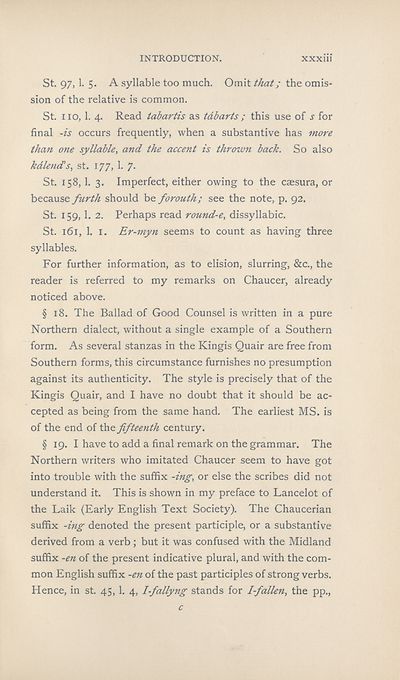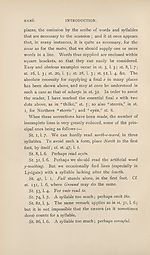Scottish Text Society publications > New series > Kingis quair; together with A ballad of good counsel
(43)
Download files
Complete book:
Individual page:
Thumbnail gallery: Grid view | List view

INTRODUCTION.
xxxui
St. 97, 1. 5. A syllable too much. Omit that; the omis¬
sion of the relative is common.
St. no, 1. 4. Read tabartis as tab arts ; this use of s for
final -is occurs frequently, when a substantive has more
than one syllable, and the accent is thrown back. So also
kdlend's, st. 177, 1. 7.
St. 158, 1. 3. Imperfect, either owing to the caesura, or
because furth should be forouth; see the note, p. 92.
St. 159, 1. 2. Perhaps read round-e, dissyllabic.
St. 161, 1. 1. Er-myn seems to count as having three
syllables.
For further information, as to elision, slurring, &c., the
reader is referred to my remarks on Chaucer, already
noticed above.
§ 18. The Ballad of Good Counsel is written in a pure
Northern dialect, without a single example of a Southern
form. As several stanzas in the Kingis Quair are free from
Southern forms, this circumstance furnishes no presumption
against its authenticity. The style is precisely that of the
Kingis Quair, and I have no doubt that it should be ac¬
cepted as being from the same hand. The earliest MS. is
of the end of the fifteenth century.
§ 19. I have to add a final remark on the grammar. The
Northern writers who imitated Chaucer seem to have got
into trouble with the suffix -ing, or else the scribes did not
understand it. This is shown in my preface to Lancelot of
the Laik (Early English Text Society). The Chaucerian
suffix -ing denoted the present participle, or a substantive
derived from a verb; but it was confused with the Midland
suffix -en of the present indicative plural, and with the com¬
mon English suffix -en of the past participles of strong verbs.
Hence, in st. 45, 1. 4, I-fallyng stands for I-fallen, the pp.,
c
xxxui
St. 97, 1. 5. A syllable too much. Omit that; the omis¬
sion of the relative is common.
St. no, 1. 4. Read tabartis as tab arts ; this use of s for
final -is occurs frequently, when a substantive has more
than one syllable, and the accent is thrown back. So also
kdlend's, st. 177, 1. 7.
St. 158, 1. 3. Imperfect, either owing to the caesura, or
because furth should be forouth; see the note, p. 92.
St. 159, 1. 2. Perhaps read round-e, dissyllabic.
St. 161, 1. 1. Er-myn seems to count as having three
syllables.
For further information, as to elision, slurring, &c., the
reader is referred to my remarks on Chaucer, already
noticed above.
§ 18. The Ballad of Good Counsel is written in a pure
Northern dialect, without a single example of a Southern
form. As several stanzas in the Kingis Quair are free from
Southern forms, this circumstance furnishes no presumption
against its authenticity. The style is precisely that of the
Kingis Quair, and I have no doubt that it should be ac¬
cepted as being from the same hand. The earliest MS. is
of the end of the fifteenth century.
§ 19. I have to add a final remark on the grammar. The
Northern writers who imitated Chaucer seem to have got
into trouble with the suffix -ing, or else the scribes did not
understand it. This is shown in my preface to Lancelot of
the Laik (Early English Text Society). The Chaucerian
suffix -ing denoted the present participle, or a substantive
derived from a verb; but it was confused with the Midland
suffix -en of the present indicative plural, and with the com¬
mon English suffix -en of the past participles of strong verbs.
Hence, in st. 45, 1. 4, I-fallyng stands for I-fallen, the pp.,
c
Set display mode to: Large image | Zoom image | Transcription
Images and transcriptions on this page, including medium image downloads, may be used under the Creative Commons Attribution 4.0 International Licence unless otherwise stated. ![]()
| Publications by Scottish clubs > Scottish Text Society publications > New series > Kingis quair; together with A ballad of good counsel > (43) |
|---|
| Permanent URL | https://digital.nls.uk/113908811 |
|---|
| Description | A collection of over 100 Scottish texts dating from around 1400 to 1700. Most titles are in Scots, and include editions of poetry, drama, and prose by major Scottish writers such as John Barbour, William Dunbar, Gavin Douglas, and George Buchanan. Edited by a key scholarly publisher of Scotland's literary history, and published from the late 19th century onwards by the Scottish Text Society. Available here are STS series 1-3. |
|---|

